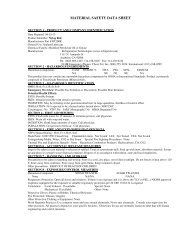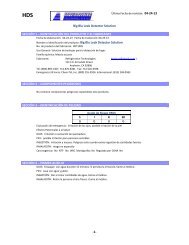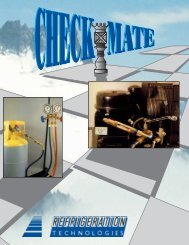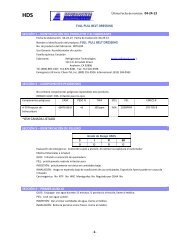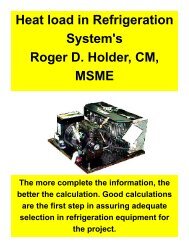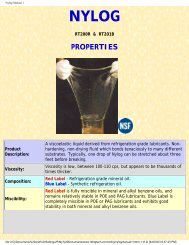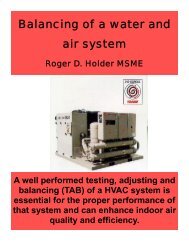Refrigeration Piping Charging Residential AirConditioning R
Refrigeration Piping Charging Residential AirConditioning R
Refrigeration Piping Charging Residential AirConditioning R
Create successful ePaper yourself
Turn your PDF publications into a flip-book with our unique Google optimized e-Paper software.
33<br />
<strong>Charging</strong> <strong>Residential</strong> Air Conditioning R-22<br />
Different types of metering devices have different ways of charging. A Thermostatic<br />
Expansion Valve (TXV) is charged to the subcooling of the liquid line leaving the<br />
condenser. A fixed orifice is charged to the superheat of the suction line leaving the<br />
evaporator. To under stand why this is, it requires an understanding of the physical<br />
properties of the refrigeration cycle. The four main components of the refrigeration<br />
cycle include:<br />
• Compressor<br />
• Condenser<br />
• Metering Devices<br />
• Evaporator<br />
These four components are divided into sections and explained in depth as follows.<br />
Compressor<br />
The Compressor compresses a low-pressure superheated gas into a high-pressure<br />
superheated gas. If the suction gas is not superheated, the compressor can be<br />
damaged. The compressor pulls the refrigerant out of the evaporator and pushes it<br />
though a condenser. The act of compression is performed by any one of the following<br />
six types of compressors: a reciprocating piston, rotary, scroll, screw, centrifugal, and<br />
sonic compressors. Of the six, the reciprocating and scroll compressors are the two<br />
most frequently found in a residential air conditioning system.<br />
The mass flow rate produced by a compressor is equal to the mass of the suction gas<br />
pulled in by the compressor. The compressor’s out put is equally only to its intake<br />
because the mass flow must be equal. The process of compression, through mass<br />
flow, raises the temperature and pressure of the refrigerant. The result of the<br />
temperature increase is superheat. Pressure and temperature of the refrigerant must<br />
be higher than the condensing temperature. The refrigerant temperature must be<br />
33




